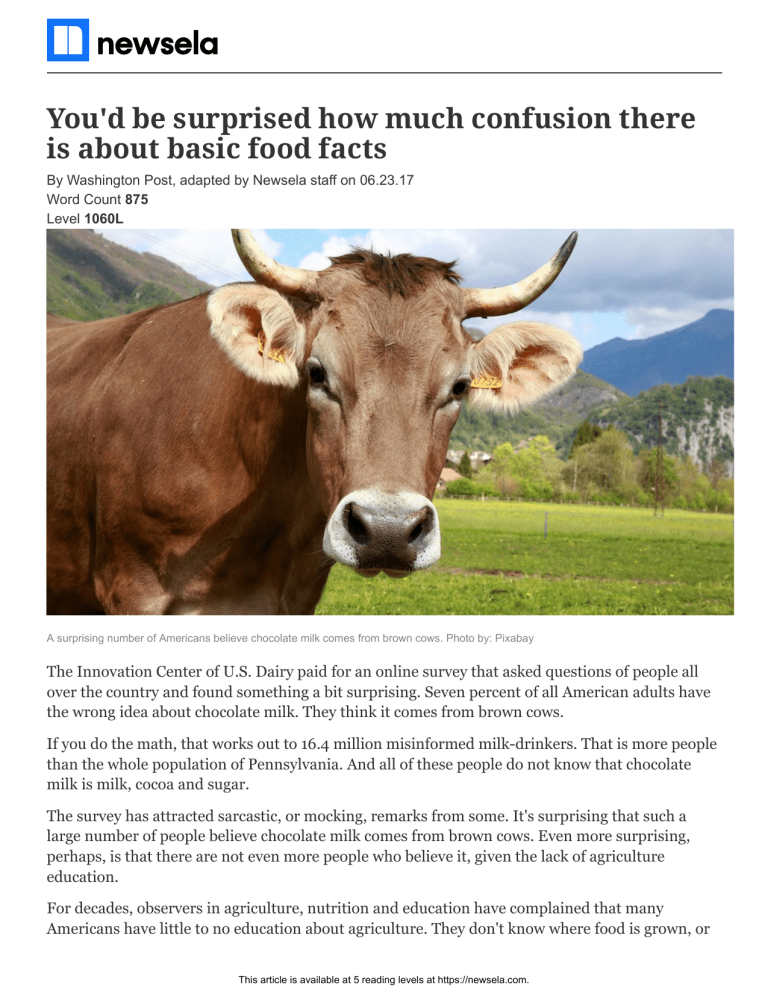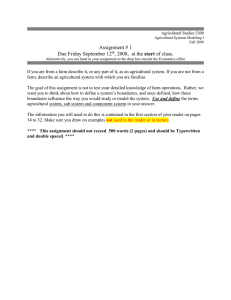
You'd be surprised how much confusion there is about basic food facts By Washington Post, adapted by Newsela staff on 06.23.17 Word Count 875 Level 1060L A surprising number of Americans believe chocolate milk comes from brown cows. Photo by: Pixabay The Innovation Center of U.S. Dairy paid for an online survey that asked questions of people all over the country and found something a bit surprising. Seven percent of all American adults have the wrong idea about chocolate milk. They think it comes from brown cows. If you do the math, that works out to 16.4 million misinformed milk-drinkers. That is more people than the whole population of Pennsylvania. And all of these people do not know that chocolate milk is milk, cocoa and sugar. The survey has attracted sarcastic, or mocking, remarks from some. It's surprising that such a large number of people believe chocolate milk comes from brown cows. Even more surprising, perhaps, is that there are not even more people who believe it, given the lack of agriculture education. For decades, observers in agriculture, nutrition and education have complained that many Americans have little to no education about agriculture. They don't know where food is grown, or This article is available at 5 reading levels at https://newsela.com. how it gets to stores. In the case of chocolate milk, they don't even know what's in it. Food Doesn't Just Come From The Store One Department of Agriculture study, commissioned in the early 1990s, found that nearly 1 in 5 adults did not know that hamburgers are made from beef. Many more lacked familiarity with basic farming facts. They did not know how big U.S. farms typically are and what food animals eat. Experts in agricultural education aren't convinced that much has changed over the years since then. "At the end of the day, it's an exposure issue," said Cecily Upton, co-founder of a nonprofit group called FoodCorps. The group brings agricultural and nutrition education into elementary schools. "Right now, we're conditioned to think that if you need food, you go to the store. Nothing in our educational framework teaches kids where food comes from before that point." Upton and other educators are quick to caution that these conclusions don't apply to everyone in the U.S. Studies have shown that people who live in agricultural communities know a bit more about where their food comes from. People with higher education levels and household incomes know more, too. What Do You Mean Pickles Are Cucumbers? But in some populations, there is much confusion about basic food facts. A team of researchers interviewed fourth-, fifth- and sixth-graders at a school in a city in California. They found that more than half of the students didn't know pickles were cucumbers. They did not know that onions and lettuce were plants. Four in 10 didn't know that hamburgers came from cows. And 3 in 10 didn't know that cheese is made from milk. The researchers said that everyone they asked "recalled the names of common foods in raw form and most knew foods were grown on farms or in gardens." However, the kids did not seem to know how items grown on a farm became common foods. In some ways, this ignorance is perfectly logical. The writer and historian Ann Vileisis has argued that it developed hand in hand with the industrial food system. She wrote about this in her book "Kitchen Literacy." As more Americans moved into cities in the mid-1800s, fewer were involved in food production or processing. That trend increased with improvements in transportation and manufacturing. These things made it possible to ship foods in different forms, and over great distances. Farm To Kitchen Is No Longer Just A Short Walk Vileisis writes that in the 20th century, "Within a relatively brief period, the average distance from farm to kitchen had grown from a short walk down the garden path to a convoluted, 1,500-mile energy-guzzling journey by rail and truck." After a while, many Americans couldn't imagine the origins of the boxed cereals or shrinkwrapped hot dogs in their kitchens. Today, many Americans only experience food as an industrial product that doesn't look much like the original animal or plant: The USDA says orange juice is the most popular "fruit" in America, This article is available at 5 reading levels at https://newsela.com. and processed potatoes — in the form of french fries and chips — rank among the top vegetables. The past 20 years have seen the birth of a movement to reverse this trend, with agriculture and nutrition groups working to get agricultural education back into classrooms. Making Agriculture Education A Priority FoodCorps worked with slightly more than 100,000 students this year. Groups like the National Agriculture in the Classroom Organization and the American Farm Bureau Foundation are actively working with K-12 teachers across the country. They are helping them add nutrition, farm technology and agricultural economics to lessons in social studies, science and health. The USDA Farm to School program, which awarded $5 million in grants for the 2017-2018 school year on Monday, also funds projects on agriculture education. Nutritionists and food-system reformers say these basic lessons are critical for kids to learn how to eat healthfully. It could be important in tackling problems like heart disease and being unhealthily overweight. Upton, of FoodCorps, said everyone could benefit from a better understanding of agriculture. "We still get kids who are surprised that a french fry comes from a potato, or that a pickle is a cucumber," she said. "... Knowledge is power. Without it, we can't make informed decisions." This article is available at 5 reading levels at https://newsela.com. Quiz 1 Which section of the article highlights the idea that Americans' knowledge about the origins of their food has been diminishing over a long period of time? (A) Introduction [paragraphs 1-4] (B) "What Do You Mean Pickles Are Cucumbers?" (C) "Farm To Kitchen Is No Longer Just A Short Walk" (D) "Making Agriculture Education A Priority" 2 Which paragraph in the section "Making Agriculture Education A Priority" BEST explains how agricultural education and health are related? 3 Which two of the following selections from the article include central ideas? Seven percent of all American adults have the wrong idea about chocolate milk. They think it comes from brown cows. 2. "Right now, we're conditioned to think that if you need food, you go to the store. Nothing in our educational framework teaches kids where food comes from before that point." 3. The researchers said that everyone they asked "recalled the names of common foods in raw form and most knew foods were grown on farms or in gardens." 4. The past 20 years have seen the birth of a movement to reverse this trend, with agriculture and nutrition groups working to get agricultural education back into classrooms. 1. 4 (A) 1 and 3 (B) 1 and 4 (C) 2 and 3 (D) 2 and 4 Read the paragraph from the section "What Do You Mean Pickles Are Cucumbers?" But in some populations, there is much confusion about basic food facts. A team of researchers interviewed fourth-, fifth- and sixth-graders at a school in a city in California. They found that more than half of the students didn't know pickles were cucumbers. They did not know that onions and lettuce were plants. Four in 10 didn't know that hamburgers came from cows. And 3 in 10 didn't know that cheese is made from milk. How does this paragraph reflect a central idea of the article? (A) It shares some survey results to support the idea that many American students do not know where their food comes from. (B) It reveals the results of the efforts of agricultural education groups in their attempt to teach American students more about nutrition. (C) It introduces the idea that Americans are confused because packaged foods do not look like the animals and plants they come from. (D) It compares the nutritional knowledge of students in an urban setting with those in an agricultural setting. This article is available at 5 reading levels at https://newsela.com.

